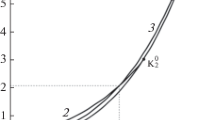Abstract
The scaling theory for tricritical phenomena by Riedel is applied to the analysis of thermodynamic properties of liquid3He-4He mixtures near the tricritical point. Within this theory experimental data for the phase diagram, the3He molar concentrationX, and the concentration susceptibility (∂X/∂Δ) T are discussed in terms of two scaling fields that are functions of the temperatureT and the difference Δ=\(\hat \mu \) 3 −\(\hat \mu \) 4 of the chemical potentials of the two helium isotopes. The quantitiesX and (∂X/∂Δ) T in terms of thefields T and Δ as independent variables are obtained for the intervals −0.1<T − T t<0.53 K and −9<Δ − Δ t <0.8 J/mole, from vapor pressure and calorimetric data described in a previous paper by Goellner, Behringer, and Meyer. The transformed data are analyzed to yield the tricritical exponents, amplitudes, scaling fields, and scaling functions. The values of the tricritical exponents are found to agree with those predicted by the renormalization-group theory of Riedel and Wegner. (Logarithmic corrections are beyond the precision of the present experiment.) Relations between amplitudes are derived and tested experimentally. The (linear) scaling fields are determined by using their relationship to geometrical features of the phase diagram. The data forX and (∂X/∂Δ) T are found to scale in terms of these generalized scaling variables. The sizes of the tricritical scaling regions in the normal and superfluid phases are estimated; the range of apparent tricritical scaling is found to be appreciably larger in the normal-fluid phase than in the superfluid phase. The tricritical scaling function for the concentration susceptibility is compared with the analogous scaling function for the compressibility of pure3He near thecritical gas—liquid phase transition. Finally, when the critical line near the tricritical point is approached along a path of constant Δ<Δ t , the experimental data are found to exhibit the onset of the crossover from tricritical to critical behavior in qualitative agreement with crossover scaling.
Similar content being viewed by others
References
R. B. Griffiths and J. C. Wheeler,Phys. Rev. A 2, 1047 (1970).
E. K. Riedel,Phys. Rev. Lett. 28, 675 (1972).
G. Goellner, R. Behringer, and H. Meyer,J. Low Temp. Phys. 13, 113 (1973).
R. B. Griffiths,Phys. Rev. Lett. 24, 715 (1970).
E. K. Riedel,AIP Conf. Proc. 18, 834 (1974).
R. B. Griffiths,Phys. Rev. B 7, 545 (1973).
D. M. Saul, M. Wortis, and D. Stauffer,Phys. Rev. B 9, 4964 (1974).
E. K. Riedel, H. Meyer, and R. P. Behringer,Bull. Am. Phys. Soc. II 19, 305 (1974).
E. K. Riedel and F. J. Wegner,Phys. Rev. Lett. 29, 349 (1972).
F. J. Wegner and E. K. Riedel,Phys. Rev. B 7, 248 (1973).
E. K. Riedel and F. J. Wegner,Phys. Rev. B 9, 294 (1974).
M. E. Fisher,Phys. Rev. 176, 257 (1968).
D. D. Betts and J. R. Lothian,Can. J. Phys. 51, 2249 (1973); D. D. Betts, inPhase Transitions and Critical Phenomena, C. Domb and M. S. Green, eds. (Academic Press, New York, 1974), Vol. 3, p. 569.
B. Widom,J. Chem. Phys. 43, 3898 (1965).
L. P. Kadanoff,Physics 2, 263 (1966).
K. G. Wilson and J. Kogut,Phys. Rep. 12C, 75 (1974).
M. E. Fisher and D. R. Nelson,Phys. Rev. Lett. 32, 1350 (1974); M. E. Fisher,AIP Conf. Proc. 24 (1975).
F. J. Wegner,Phys. Rev. B 5, 4529 (1972).
M. Blume, V. J. Emery, and R. B. Griffiths,Phys. Rev. A 4, 1071 (1971).
R. B. Griffiths,Phys. Rev. 158, 176 (1967).
M. Vicentini-Missoni, J. M. H. Levelt Sengers, and M. S. Green,J. Res. NBS 73A, 563 (1969).
S. G. Sydoriak and T. R. Roberts,Phys. Rev. 118, 901 (1960).
S. T. Islander and W. Zimmermann,Phys. Rev. A 7, 188 (1973).
G. Ahlers and D. S. Greywall, inLow Temperature Physics—LT 13, K. D. Timmerhaus, W. J. O'Sullivan, and E. F. Hammel, eds. (Plenum, New York, 1974), Vol. 1, p. 586.
E. H. Graf, D. M. Lee, and J. D. Reppy,Phys. Rev. Lett. 19, 417 (1967).
P. Leiderer, D. R. Watts, and W. W. Webb,Phys. Rev. Lett. 33, 483 (1974).
E. K. Riedel, unpublished.
C. A. Gearhart and W. Zimmerman,Bull. Am. Phys. Soc. II 20, 617 (1975).
B. Wallace and H. Meyer,Phys. Rev. A 2, 1567 (1970); Technical Report, Duke University (1972).
G. F. Tuthill, F. Harbus, and H. E. Stanley,Phys. Rev. Lett. 31, 527 (1973).
M. Blume, L. M. Corliss, J. M. Hastings, and E. Schiller,Phys. Rev. Lett. 32, 544 (1974).
E. K. Riedel and F. J. Wegner,Z. Physik 225, 195 (1969).
Author information
Authors and Affiliations
Additional information
Work supported in part by the National Science Foundation through Grant No. GH-36882 and Grant No. GH-32007, and by a grant of the Army Research Office (Durham).
Rights and permissions
About this article
Cite this article
Riedel, E.K., Meyer, H. & Behringer, R.P. Thermodynamic properties of liquid3He-4He mixtures near the tricritical point. II. Data analysis by the scaling-field method. J Low Temp Phys 22, 369–402 (1976). https://doi.org/10.1007/BF00654713
Received:
Issue Date:
DOI: https://doi.org/10.1007/BF00654713



